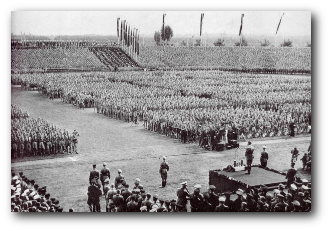This week I attended the UXBrighton conference, and was very impressed by the size and experience demonstrated by the Brighton UX community. The conference was an extension of the monthly UXBrighton meetings, who moved for the first time to a bigger venue – necessitated by the prestige of their special guest Rory Sutherland, as documented by James Page. The conference can be called an undeniable success for the local community, with 250 people in attendance, and a full day of interesting and enlightening talks.

attendance was looking good
The day was bookended by presentations from Eric Reiss, and Rory Sutherland. Both speakers were charismatic and good choices as the key speakers of the day. Reiss’s talk, on ‘Web Dogma’, introduced a high level overview to some of the key concepts of the day – advocating the idea of ‘user driven design’ at every stage of a project, and introducing his list of 10 basic rules for web communication. These rules aim to separate best practices from technology and fashion, and hence avoid the fate of the Dogme95 movement which inspired their creation. Although possibly too ‘high-level’ for a UX specific conference, Eric Reiss’s presentation was fun, full of character, and engaging, since he treated his presentation as an independent being imbued with a personality of it’s own (more on this later!). Eric Reiss’s full list of rules for web design have been widely adopted across the net, and can be seen here: Web Dogma.
Rory Sutherland’s talk ‘Of Clouds and Clocks’ was a fun ending to the day, and expanded the day’s discussions beyond the realm of just user experience. Sutherland based his talk around Karl Popper’s idea that most things are either clocks, and hence act predictably and mechanically, or clouds, which are much more complex systems and hence less easy to adjust. Popper said that the worst mistakes are made by people treating clouds like clocks (such as terrorists attempting to fix society with a bomb), and Sutherland points out that this applies to traditional interpretations of business. Instead of focusing on grand actions to change business, it is instead the accumulation of small actions, and an oblique approach to fixing a problem, that often proves successful. Sutherland’s infectious humour and personality shone through his presentation, and he provided an inspiring ‘wake up’ rally at the end of a long day! Rory Sutherland’s TED talk can be seen here
Other highlights of the day included Harry Brignull’s talk on the evil tricks designers use to control of your actions. Brignull has started to document these on his very interesting darkpatterns.org website, and used his talk to propose a code of ethics to help combat these tricks.
Graham McAllister presented some of Vertical Slice’s methods of biometrics research within games, which I’ve written about before. His talk seemed well received by the crowd, and gave an interesting example of the application of UX principles outside of websites.
Jeroen Van Goel, of Johnny Holland Magazine gave a fun presentation of the personality inherent in products, such as his washing machine, and how we as UX designers need to consider the personality of websites as we make them. By learning from the established field of branding, we can overcome the constraints set by design patterns and simple usability testing, to create ‘likeable’ products.

My own washing machine has seen unimaginable horrors...
Bunnyfoot’s Jon Dodd showed us how the teachings of advertising guru David Ogilvy still apply in the 21st century. His insights, revolutionary in the world of advertising, including using metrics, a/b testing, and talking to customers, and are all key aspects of creating successful user experiences. Dodd’s talk has inspired me to re-read Ogilvy’s classic “On Advertising”. Dodd also recommended Ogilvy’s ,“Theory and Practise of selling the Aga Cooker”.
Further talks, from James Page, Sabrina Mach, Claire Rowland and Julian Hirst, covered a diverse range of topics, from the nature of creativity, to the introduction of UCD into the methodology’s used in large businesses, to the advantages of remote user testing.
UX Brighton proved that the Brighton UX community can fill a conference venue, and put on a day of interesting and relevant talks. It was especially interesting playing ‘spot the twitterer’, as I spotted many people I’ve been twitter stalking for the first time. I’m sure after the success of 2010, the organisers will be looking to put on a UXBrighton 2011, and I’m already looking forward to the discussion of next year’s hot topics!
Leave a Reply